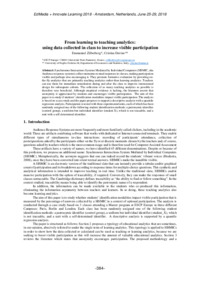From learning to teaching analyticsusing the data collected in class to increase visible participation
Emmanuel Zilberberg, Cristina Davino
Zu finden in: EdMedia 2018, 2018
|
 |
 Diese Seite wurde seit 4 Jahren inhaltlich nicht mehr aktualisiert. Unter Umständen ist sie nicht mehr aktuell.
Diese Seite wurde seit 4 Jahren inhaltlich nicht mehr aktualisiert. Unter Umständen ist sie nicht mehr aktuell. Zusammenfassungen
Zusammenfassungen
Synchronous Interactions Systems Mediated by Individual Computers (SISMIC, aka Audience response systems) collect numerous textual responses in classes, making participation visible and perhaps also encouraging it. They promote formative evaluation by providing on-the-fly analytics that are primarily teaching analytics rather than learning analytics. Teachers can use them for immediate remediation during and after the class to improve instructional design for subsequent cohorts. The collection of as many teaching analytics as possible is therefore very beneficial. Although empirical evidence is lacking, the literature asserts that anonymity is appreciated by students and encourages visible participation. The aim of this paper is to study if students’ identification modalities impact visible participation. The analysis is based on a case study and the paper proposes to support a descriptive analysis with a quantile regression analysis. Participation is tested with three experimental units, each of which has been randomly assigned one of the following student identification methods: a patronymic identifier (control group), a uniform but individual identifier (student X), which is not traceable, and a unit with a self-determined identifier.
Von Emmanuel Zilberberg, Cristina Davino im Konferenz-Band EdMedia 2018 (2018) im Text From learning to teaching analytics  Dieses Konferenz-Paper erwähnt ...
Dieses Konferenz-Paper erwähnt ...
 Begriffe KB IB clear | Classroom response systemClassroom response system,  learning analytics learning analytics learning analytics learning analytics |
 Volltext dieses Dokuments
Volltext dieses Dokuments
 |  From learning to teaching analytics: using the data collected in class to increase visible participation: Volltext als PDF ( From learning to teaching analytics: using the data collected in class to increase visible participation: Volltext als PDF ( : :  , 207 kByte; , 207 kByte;  : :  2021-03-21) 2021-03-21) |
 Anderswo suchen
Anderswo suchen 
 Beat und dieses Konferenz-Paper
Beat und dieses Konferenz-Paper
Beat hat Dieses Konferenz-Paper während seiner Zeit am Institut für Medien und Schule (IMS) ins Biblionetz aufgenommen. Er hat Dieses Konferenz-Paper einmalig erfasst und bisher nicht mehr bearbeitet. Beat besitzt kein physisches, aber ein digitales Exemplar. Eine digitale Version ist auf dem Internet verfügbar (s.o.). Aufgrund der wenigen Einträge im Biblionetz scheint er es nicht wirklich gelesen zu haben. Es gibt bisher auch nur wenige Objekte im Biblionetz, die dieses Werk zitieren.









 Biblionetz-History
Biblionetz-History